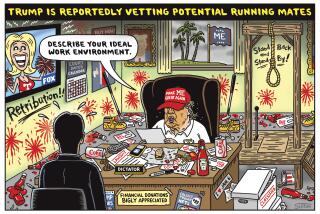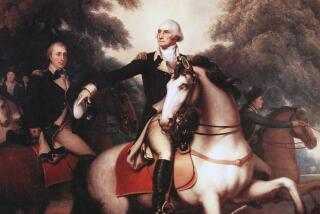George W. Bush’s unusually frank portrait
If you were a former president of the United States and the time came to have yourself recorded for posterity in an official oil portrait, would you choose to be portrayed next to a smooth-talking horse thief fleeing a lynch mob? How about pillaging bandits? Or maybe the minions of rapacious timber barons?
Probably not. Unless, that is, you are George W. Bush.
The official portrait of the 43rd president of the United States by Austin, Texas, painter John Howard Sanden was unveiled at a White House ceremony Thursday. In it, Bush’s face is shown right next to one of his favorite paintings, which hangs over his right shoulder on an Oval Office wall. Below the painting his hand rests on a chair-back sporting a golden imperial laurel wreath, ancient symbol of triumph.
The painting is a dusky scene of men galloping on horseback up a wilderness ridge. Its nickname is “A Charge to Keep” -- also the title of Bush’s ghost-written 1999 campaign autobiography (the painting is reproduced on the book’s back cover) and from lyrics to an 18th century Methodist hymn by Charles Wesley, adapted from Leviticus [8:35]. The picture dates from 1916, painted as a magazine illustration by German-born immigrant Wilhelm Heinrich Detlev Koerner, known to friends as “Big Bill.”
A book-jacket blurb explains what the painting, which Bush owns, means to him: Horsemen “determinedly charging up what appears to be a steep and rough trail. This is us.” Bush imparts a Christian meaning to the image -- “that we serve One greater than ourselves” -- although that isn’t quite what Koerner had in mind when he painted this particular canvas.
As journalist Jacob Weisberg first reported in his 2008 book, “The Bush Tragedy,” the former president’s confusion likely stems from a romance tale in a popular business magazine. The Koerner painting was used to illustrate a 1918 story published in The Country Gentleman, which told of a son who receives a pristine forest as a legacy from his father, accompanied by a plea to protect it from exploitation.
But expensively commissioned magazine illustrations were often used more than once -- recycled by publications for new articles with very different subjects. (Photojournalism didn’t become commonplace until the 1920s.) This painting had already appeared twice, most recently for “Ways That Are Dark,” which ran in a 1917 Saturday Evening Post. That story had no religious overtones. Below the picture of Bush’s imagined galloping missionaries was the caption: “Bandits Move About from Town to Town, Pillaging Whatever They Can Find.”
It gets worse. Weisberg also unearthed the original commission. Koerner painted the picture for a cowboy-themed short story titled “The Slipper Tongue,” likewise published in The Saturday Evening Post. What was the rip-roaring tale that inspired the image?
“The story is about a smooth-talking horse thief who is caught, and then escapes a lynch mob in the Sand Hills of Nebraska,” Weisberg wrote. “The illustration depicts the thief fleeing his captors. In the magazine, the picture bears the caption: ‘Had His Start Been Fifteen Minutes Longer He Would Not Have Been Caught’.” In a surprise ending, the horseman being chased turns out to be the real hero, while the pursuers are the crooks.
Official portraiture is usually meant to flatter. Rarely is it so frank as Bush’s White House painting. As reported in The Times, the former president said at the unveiling ceremony that the Koerner painting reminded him of all the people he served with during his two terms in office -- a presidency marked by a questionable 2000 election, an unprovoked war, crushing debt, charges of torture and, finally, economic collapse. Now, thanks to his official portrait, “43” will stare into space for eternity next to a picture of an apparent criminal who is heading for the hills.
Mission accomplished.
Photo: Pres. and Mrs. Bush unveil his official White House portrait; Credit: Olivier Douliery/MCT
More to Read
The biggest entertainment stories
Get our big stories about Hollywood, film, television, music, arts, culture and more right in your inbox as soon as they publish.
You may occasionally receive promotional content from the Los Angeles Times.







